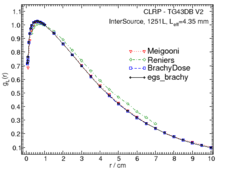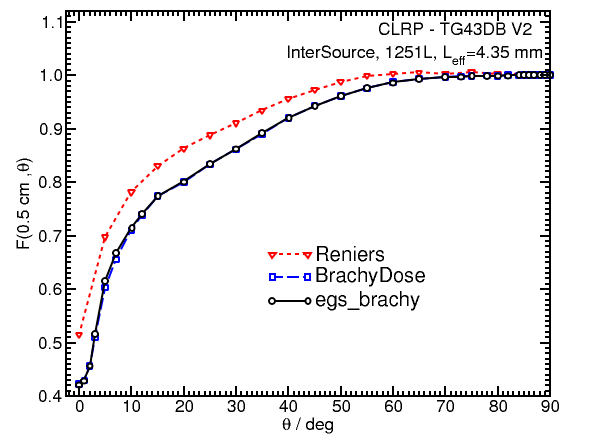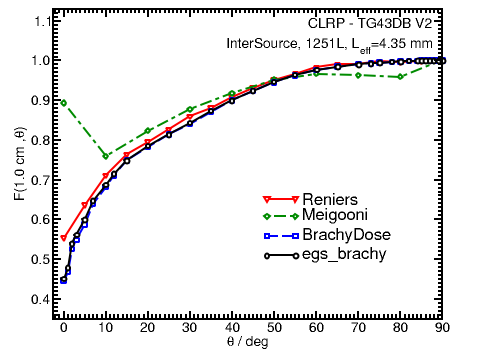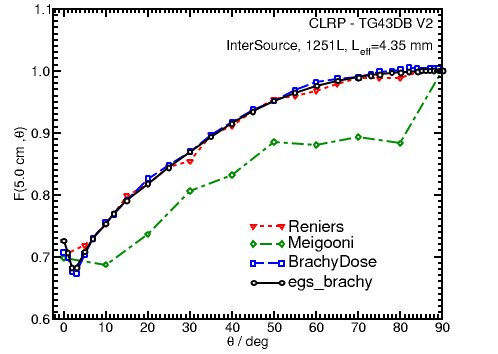
Source Description:
Dimensions for the InterSource seed1,2 are taken from the study by Meigooni et al 1 and Reniers et al 2.The InterSource consists of two concentric hollow titanium cylindrical tubes which are laser welded together at the ends. The gas between the 2 tubes is assumed to be air. The total length of laser welded end cap is taken to be 0.2 mm. Each tube is 0.040 mm thick and the outer diameter of the inner and outer tubes are 0.50 mm and 0.81 mm, respectively. There is a thin band (0.045 mm thick and 1.27 mm long) of 90% Pt / 10% Ir alloy deposited on top of the inner cylinder at its center. The radioactive 125I is distributed uniformly throughout three cylindrical bands of an organic material (85.7% carbon 14.3% hydrogen with a density of 1.0 g/cm3, the 125I content is assumed to be negligble). The outer two bands of radioactive material are deposited on the inner cylinder and are 0.80 mm long, 0.015 mm thick and have their centers along the seed axis offset 1.45 mm from the middle of the seed. The center band is 0.50 mm long, 9.0x10-3 mm thick and is deposited on top of the Pt/Ir alloy. The overall length is 4.5 mm and the active length of the seed is 4.35 mm. The mean photon energy calculated on the outer surface of the source is 28.32 keV with statistical uncertainties < 0.009%
Dose-Rate Constant - Λ :
Dose-rate constants, Λ , are calculated by dividing the dose to water per history in a (0.1 mm)3 voxel centered on the reference position, (1 cm, Π/2), in the 30x30x30 cm3 water phantom, by the air-kerma strength per history (scored in vacuo). As described in ref. 3, dose-rate constants are provided for air-kerma strength calculated using voxels of 2.66x2.66x0.05 cm3 (WAFAC) and 0.1x0.1x0.05 cm3 (point) located 10 cm from the source. The larger voxel size averages the air-kerma per history over a region covering roughly the same solid angle subtended by the primary collimator of the NIST WAFAC 4,5 used for calibrating low-energy brachytherapy sources and is likely the most clinically relevant value. The small voxel serves to estimate the air-kerma per history at a point on the transverse axis and includes a small 1/r2 correction (0.5%) 3. egs_brachy and BrachyDose MC uncertainties are statistical uncertainties only (k=1).
| Author | Method | Λ (cGy h-1 U-1) | Abs. Uncertainty |
| Safigholi et al 6 | WAFAC | 0.9940 | 0.0001 |
| Safigholi et al 6 | point | 0.9954 | 0.0019 |
| Taylor, Rogers 7 | WAFAC | 0.992 | 0.001 |
| Taylor, Rogers 7 | point | 0.995 | 0.003 |
| Meigooni et al 1 | point (PTRAN) | 1.013 | 0.03 |
| Meigooni et al 1 | TLD | 1.014 | 0.08 |
| Reniers et al 2 | TLD | 1.05 | 0.07 |
| Reniers et al 2 | point (MCNP) | 1.02 | 0.01 |
| Rodrigerz, Rogers 8 | TLD Revised (Meigooni) | 0.976 | 0.056 |
| Rodrigerz, Rogers 8 | WAFAC (BrachyDose) | 0.991 | 0.0015 |
| Rivard et al 9 | Consensus Value | 1.038 | --- |
Radial dose function - g(r):
The radial dose function, g(r), is calculated using both line and point source geometry functions and tabulated at 36 different radial distances ranging from 0.05 cm to 10 cm. Fit parameters for a modified polynomial expression are also provided 10. The mean residual deviations from the actual data for the best fit were < 0.57%.
Click image for higher res version| Fitting coefficients for g L (r) = (a0 r-2 + a1 r-1 + a2 + a3r + a4r2 + a5 r3) e-a6r | |||
| Fit range | Coefficients | ||
| r min (cm) | r max (cm) | ||
| 0.05 | 10.0 | a0 / cm2 | (2.82+/-0.06)E-03 |
| a1 / cm | (-7.28+/-0.13)E-02 | ||
| a2 | (1.225+/-0.007)E+00 | ||
| a3 / cm-1 | (1.58+/-0.21)E-01 | ||
| a4 / cm-2 | (-2.83+/-0.06)E-02 | ||
| a5 / cm-3 | (1.19+/-0.05)E-03 | ||
| a6 / cm-1 | (2.47+/-0.12)E-01 | ||
Anisotropy function - F(r,θ):
Anisotropy functions are calculated using the line source approximation and tabulated at radii of 0.1, 0.15, 0.25, 0.5, 0.75, 1, 2, 3, 4, 5, 7.5 and 10 cm and 32 unique polar angles with a minimum resolution of 5 ° . The anisotropy factor, φan(r), was calculated by integrating the solid angle weighted dose rate over 0° ≤ ϑ ≤ 90 ° .
Click images for higher res versions
Tabulated data:
Tabulated data are available in .xlsx format: Excel
References:
1. A. S. Meigooni et al, Determination of the dosimetric characteristics of InterSource 125I brachytherapy source, Appl. Radiat. Isotopes, 56, 589-599, 2002
2. B. Reniers et al, Dosimetric study of the new InterSource125 iodine seed, Med. Phys., 28, 2285-2299, 2001
3. R. E. P. Taylor et al, Benchmarking BrachyDose: voxel-based EGSnrc Monte Carlo calculations of TG-43 dosimetry parameters, Med. Phys., 34, 445 - 457, 2007
4. R. Loevinger, Wide-angle free-air chamber for calibration of low-energy brachytherapy sources, Med. Phys., 20, 907, 1993
5. S. M Seltzer et al, New National Air-Kerma-Strength Standards for 125I and 103Pd Brachytherapy Seeds, J. Res. Natl. Inst. Stand. Technol., 108, 337 - 358, 2003 6. H. Safigholi, M. J. P. Chamberland, R. E. P. Taylor, C. H. Allen, M. P. Martinov, D. W. O. Rogers, and R. M. Thomson, Update of the CLRP TG-43 parameter database for the brachytherapy, to be published (Current calculation)
7. R. E. P. Taylor, D. W. O. Rogers, An EGSnrc Monte Carlo-calculated database of TG-43 parameters, Med. Phys., 35,4228-4241,2008 8. M. Rodriguez and D. W. O. Rogers, Effect of improved TLD dosimetry on the determination of dose rate constants for 125I and 103Pd brachytherapy seeds, Med.Phys., 41, 114301, 2014
9. M. J. Rivard et al, Supplement to the 2004 update of the AAPM Task Group No. 43 Report, Med. Phys., 34, 2187 - 2205, 2007
10. R. E. P. Taylor, D. W. O. Rogers, More accurate fitting of 125I and 103Pd radial dose functions, Med. Phys., 35, 4242-4250, 2008
Back to seed index
Carleton Laboratory for Radiotherapy Physics
CLRP TG-43 Parameter Database V2
May 5, 2020



